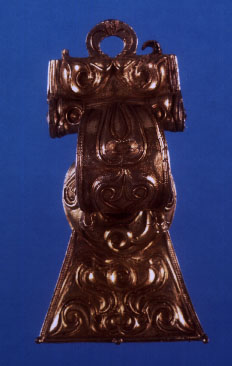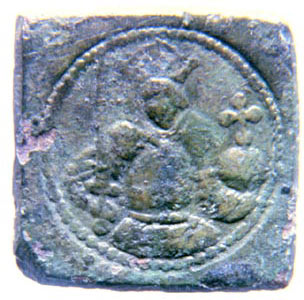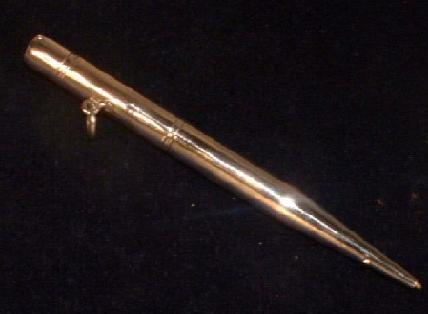|
|
|
 |
The Aesica Brooch is
one of the most famous Celtic artefacts from Roman
Britain. It was found in September 1894 during the
excavation of the west guard chamber of the south gate of
Great Chesters fort (Aesica) on Hadrian's Wall.
Unfortunately, no archaeologist was on site at the time
and the brooch, with the rest of the hoard of gold,
silver and gilt jewellery found at the same time, simply
fell out of the section. The brooch is of gilded bronze and is cast in two parts which slot together: the upper part consists of the curved bow and the square headplate, the disc and fantail foot form the lower part. The brooch is decorated all over by swirling designs of trumpet scrolls in relief within a beaded border. There has been much discussion about this brooch over the years but it is now generally agreed that it was a product of a north of England Celtic workshop, possibly in Yorkshire, around 70 or 80 AD. Typologically, it can be seen as a development of the Continental thistle brooch, which can be found throughout the Rhineland and Gaul with some examples in Pannonia. Although parallels of the form and the decoration can be identified in Britain the Aesica brooch remains unique in bringing all the elements together in one piece of jewellery. |
 |
Brass coin weights were necessary to verify the values of gold and silver coins. Unlike our small change which only represents worth, the value of colonial coinage was determined by its gold or silver content. As a consequence, it was a common practice to clip coins for the metal. This illegal practice was not always detectable on the hammered coins made before 1662 which, unlike the later machine-made coinage, were not finished with a milled edge. The coin weight example to the left is for the gold ryal, which was struck during Elizabeth 1's reign between 1583 and 1592 and valued at 15 shillings. It has a hand mark on the other side that signifies the weight was made in Antwerp. |
 |
This lead plummet was
found in Staffordshire in the mid 1980's, and sent to the
British Musuem to be identified. After identification it
was shown in the AGE OF CHIVALRY exibhition by the Royal
Acadamy of Arts, in 1987/88. The following write up is
taken from the exhibition catalogue: Modern pencils are of graphite, which was not used for writing instruments in England before the sixteenth century. But from the very late eleventh century, metallic lead was used to rule the parchment page: it superseded blind ruling (with a hard point) by the third quarter of the twelfth century and remained the commonest means of ruling until its gradual replacement by ink, including coloured inks for ornamental ruling, from the fifteenth century onwards. Lead was expensive - which was why it was so little used for roofs - and so it was worth casting this plummet with a hole at one end, for securing it, and with the name Roger, presumably its owner. A very fine late thirteenth-century plummet or lead stylus found in the Seine was lettered KAROLI SCRIPTORIS, 'of Charles the Writer'. Roger's plummet, unlike this and other plummets thought to have been used for writing, is not pointed at one end, but it is worn and perhaps once had a sharper point; and other uses (such as for a plumb-line's weight) seem unlikely.
|
 |
The bain of many
British detectorists life is horseshoes, this is not the
case with us. Some think that a horseshoe is lucky (not
for the horse that lost it) but most of the detectorists
I know hate it when they come across a horseshoe that
gives such a strong signal and they dig down only to have
their efforts rewarded with a rusty old horse shoe. I’m
not one of them, I am happy to believe that every object
that I find has some sort of history attached to it, and
the horse shoes that I recover are exactly the same. Take
for instance a large Shire Horse or a Clydesdale, now
these were animals of immense power that farmers relied
on for the real heavy work before the advent of tractors
and other fuel powered machinery. They would work from
dawn to dusk with very little rest and there was normally
a very close relationship with their owners. The example of a horseshoe to the left is
a medieval example after preseravtion and was found in
Holland. |
 |
Edward VIII Silver pencil. Hallmarked in Birmingham England in 1936 (This was the King who abdicated after only a year on the throne to marry Mrs Simpson.) Anything Hallmarked in this year is a little more collectable. The pencil is just under 4 inches long. In working order you move the length of the lead by twisting the pencil, there is an end section where the spare leads are stored. |
The Find Pages And Other Links